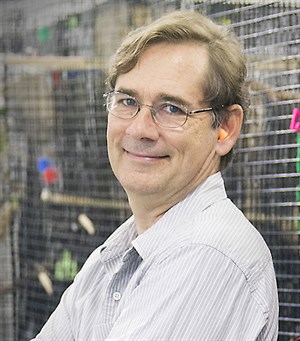Texas A&M Professor Explores Why Peruvian Parrots Eat Clay
For more than 16 years, researchers and volunteers have been observing wildlife along the clay cliffs of Southeastern Peru’s Tambopata River. They’ve gathered data every day, logging more than 20,000 hours and building one of the most extensive datasets on tropical parrots in the world.

In a new paper published in Ibis, Elizabeth Hobson, a postdoctoral fellow with the Arizona State University-Santa Fe Institute Center for Biosocial Complex Systems, and Donald J. Brightsmith, a professor in the Texas A&M University College of Veterinary Medicine & Biomedical Sciences (CVM) and director of the Tambopata Macaw Project, begin to analyze the data from this long-term study.
In particular, the two explore the potential drivers behind geophagy — or intentional soil consumption — they’ve regularly observed in 14 different parrot species there.
This region of the Tambopata River in Southeast Peru is an ideal spot to study the nearly two-dozen parrot species that live nearby in the Amazon rainforest. In the thick foliage of the jungle, the birds are difficult to see, but when they emerge to gather up beakfuls of the sodium-rich clay soil, “it’s a crazy, screaming kaleidoscope of color,” Hobson said.
“They’re all quiet when they take flight, but in a few seconds, they all begin to scream, and some drop bits of the clay from their mouths,” said Brightsmith, who has led the Tambopata Macaw Project since 1999. “It’s an incredible experience.”
But the parrot’s geophagy is a somewhat confounding behavior—clay soil is basically inert.
“It doesn’t have proteins, carbohydrates, or really anything that you’d need,” Brightsmith said. “If we can understand why it’s so important to these parrots, we can learn more about the ecosystem and how it affects the other insects, birds, and mammals who also eat this soil.”
Geophagy occurs around the world and in many types of animals, and scientists have proposed many explanations for the behavior. In their paper, Hobson and Brightsmith explore the two leading theories for these Amazonian parrots—that clay soils help protect the birds from food toxins when ideal food sources are scarce and that clay soils provide necessary minerals not available in the parrots’ regular diet.
Like previous studies, their analysis suggests that toxin-protection is not a driver. But parrot geophagy there is highly correlated with breeding season, suggesting the increased nutritional demands are likely behind the soil consumption. This study also joins a large body of research suggesting that hunger for sodium, specifically, is that driver.
“There’s lots of evidence that’s pointing in that direction,” Hobson said. “Sodium in the rainforest is really rare, and the place on these clay licks most preferred by the birds also has the highest sodium content.”
Understanding how nutritional needs are—and are not—being met during breeding season becomes even more important in light of climate change, according to Brightsmith. Some of the larger macaws are already breeding right before a seasonal crash in food supply, requiring parents take their fledgling young on long flights to find food.
“If climate change starts messing with the macaw’s food supply, it could disrupt their ability to breed,” he said.


